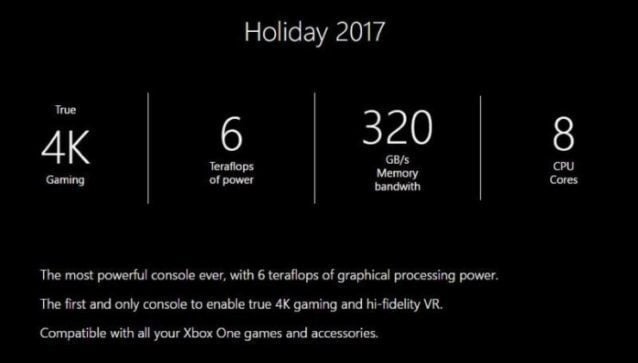
Project Scorpio has been the topic of several discussions lately, and following the impressive technical overview courtesy of Digital Foundry those discussions are likely to continue and will lead into this year’s E3 where the next Xbox will hopefully be fully unveiled — name and all.
The steady stream of news continues on behalf of Windows Central with the confirmation that Project Scorpio will support Shader Model 6 at launch, allowing for more efficient resource usage across the board. The good news is the revised Xbox won’t be the only one to benefit as the update will be extended to existing Xbox One consoles.
Microsoft intends to showcase how those with the intended 4K TV and older HD displays will benefit as well. Games supporting native 4K assets will leverage improved visual quality on older HD displays courtesy of supersampling. For those wondering, the general idea behind the technique is taking an image rendered at a higher resolution and subsequently downsampling that image to the original resolution.
Games supporting 4K through an update will also see improved image quality on older HDTV’s as the otherwise wasted resolution bump will be used to sharpen details. Additionally, existing titles that utilize dynamic scaling on Xbox One will benefit from the additional overhead and will be able to achieve their target resolutions more frequently, if not permanently.

Early Project Scorpio Xbox Development Kits (XDK) are already out in the wild, and the roadmap detailing the evolution of the software powering Project Scorpio is discussed in a separate Windows Central article. The kits are currently operating below 80 percent of the planned system performance when it launches this holiday season.
The roadmap outlines that optimizations will allow the console to hit anywhere between 80 and 90 percent of the intended performance goal courtesy of an XDK update in May. Things look to heat up with the June XDK update that will bring Scorpio in-line with the original six-teraflop figure spoken of last year.
Even more interesting, should everything go according to plan, developers will begin submitting games for certification with the platform with the June update. Scorpio will boost Xbox One games utilizing dynamic scaling without the need for an update or patch. The result is a similar one to the “Boost Mode” on the PlayStation 4 Pro, allowing even un-patched Xbox One titles to benefit from the additional overhead offered by Scorpio.

With the target being 4K, developers will be able to bake in the relevant assets and code into a game for use across the Xbox One and Project Scorpio, and can even go one step further by designating these features only be triggered upon detecting the higher-specced Xbox.
This is interesting for a number of reasons: it gives developers the choice of dispatching Scorpio features separately alongside the platform’s launch later this year, and it will maintain download sizes and restrict features that are otherwise incapable of being used on an original Xbox One.
All things considered, whether you’ve opted for an Ultra HD display or are still holding onto an older HDTV with no intention of upgrading to a more expensive TV for the foreseeable future, Project Scorpio will provide a significant advantage over today’s Xbox One console.
Getting the most out of the hardware will require a 4K display, and with the confirmation that the machine will host a 4K-capable Blu-ray player — a one-up on the PS4 Pro that only supports 4K video content via streaming services — the outlook suggests Scorpio will be around for quite some time.
Be sure to keep an eye peeled to GTPlanet for more on the uber-Xbox as it becomes available.
[Sources: Windows Central – Supersampling Benefits, XDK Roadmap]
See more articles on 4K Resolution, Project Scorpio, and Xbox One.










